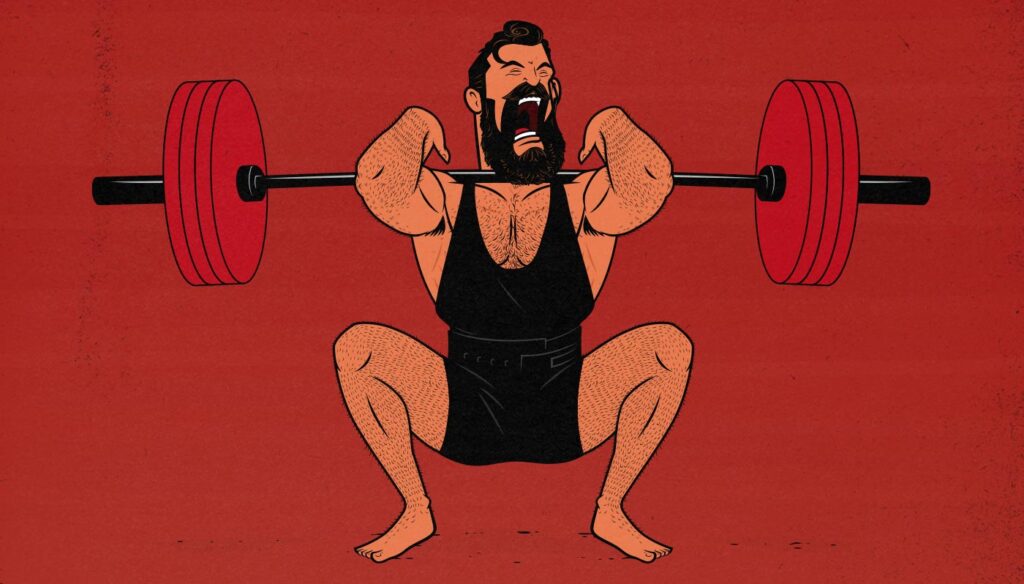
Lifting Tempo: How Fast Should You Lift & Lower Weights to Build Muscle?
Lifting tempo is one of the more minor muscle-growth factors, not because it doesn’t matter, but because most people have a good intuition for it. Most people lift in the way that makes them stronger, and that’s also a pretty good way to lift for muscle growth. Still, there are ways that we can improve our lifting tempo, eking out a little bit more muscle growth with every repetition.
But there are also some trends that might hurt more than they help. For example, should we pause with the barbell on our chest when bench pressing? Should we drop the barbell down to the floor when deadlifting? Should we slow down our lifts to get a better mind-muscle connection?
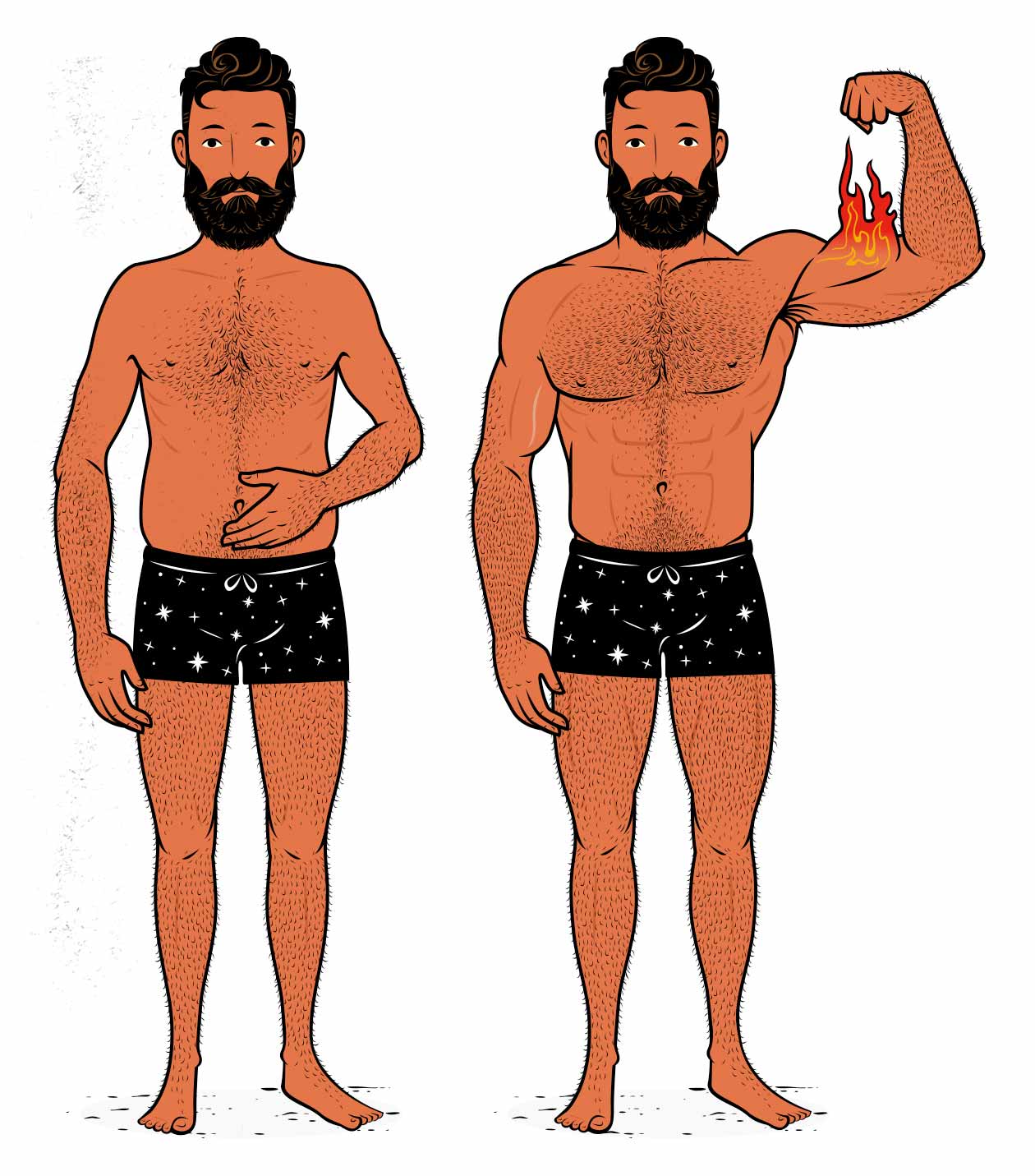
Video Version
If you’d rather watch than read, we’ve got a video on lifting tempo up on our YouTube channel:
What Is Lifting Tempo?
When lifting weights, the “tempo” is how quickly we lower the weight (the eccentric), how long we pause under tension (the isometric), and how quickly we lift the weight (the concentric).
Different weight lifting tempos are used for different goals. Olympic weightlifting is fast and explosive, throwing the weight up and dropping it down. Strength training is slower and more methodical, using heavier weights that are harder to move quickly, and often with strategic pauses under tension. Both of these training styles stimulate some muscle growth, but neither are ideal for gaining muscle mass.
If we’re doing hypertrophy training, trying to gain muscle mass, how quickly should we be lifting and lowering the weights? Should we be lifting explosively? Should we be pausing? And should we ever drop the weights?
What Lifting Tempo is Best for Building Muscle?
The Pros and Cons of Lifting Slow
A popular tempo with bodybuilders is to lift weights slowly and under control, really trying to feel the target muscles doing the work. This is thought to create a better mind-muscle connection, allowing them to get better muscle activation in their target muscles. These tempos are often fairly intuitive, with the lift taking a couple seconds, maybe a pause at the top to feel the contraction, and then the lower taking another few seconds. We get a repetition that lasts, say, 5–10 seconds.
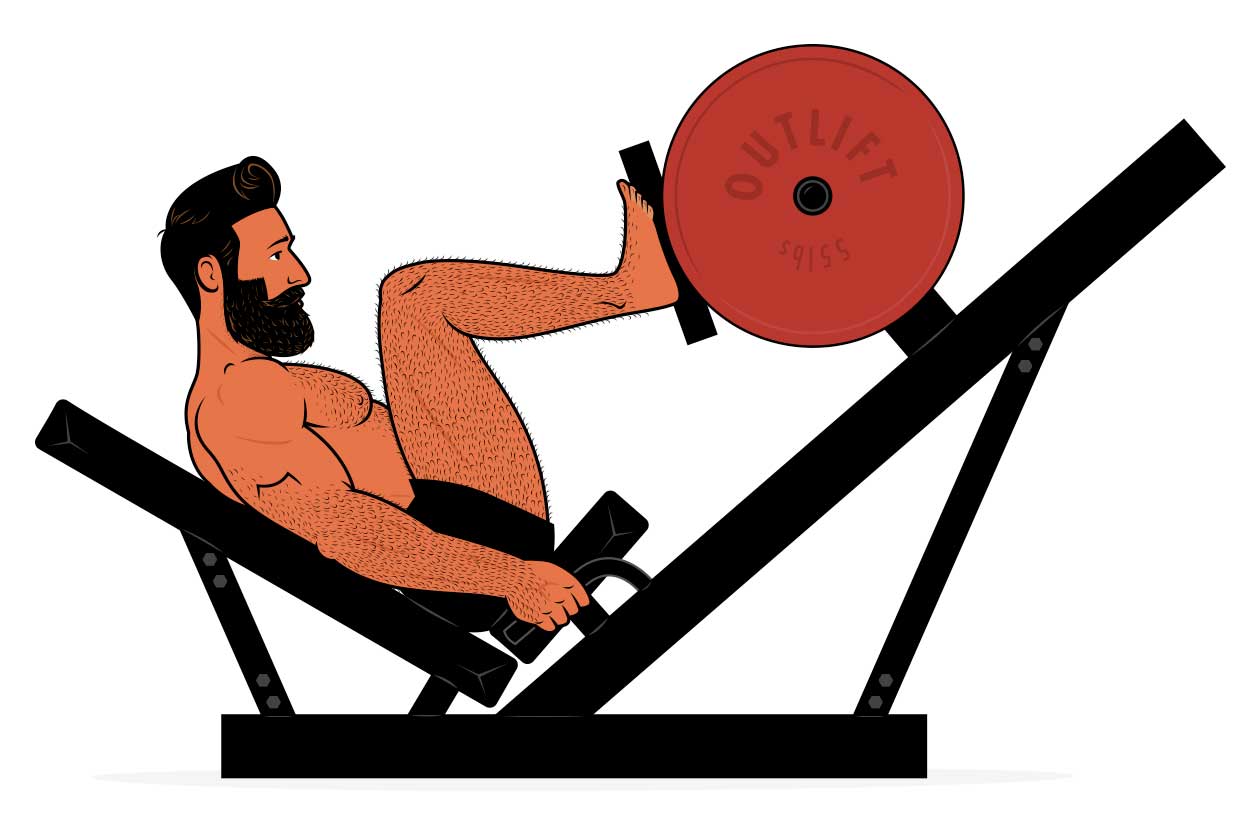
Lifting weights slowly allows us to maintain good control of the weights, and means that our muscles are under tension for longer. But it also forces us to use lighter weights, canceling out the advantages (study). For example, a study by Keogh et al found that using a slower lifting tempo forced the participants to use weights that were around 35% lighter, resulting in muscle activation that was around 25% lower. Still, if we take the set to failure, we’ll have fatigued all of our muscle fibres, stimulating at least some growth in them (study). So we’re getting less mechanical tension over a longer period of time, not so dissimilar from just lifting in a higher rep range.
Still, there are some real advantages to slowing down our reps. The reason why it’s so popular among bodybuilders is because it allows them to feel their target muscles doing the work, gives them greater control over their technique, and keeps their lifting fairly safe. Does this improve overall muscle growth? Maybe not. But for some people, it can teach them how to better target certain muscles. For other people, it keeps their lifting technique safe.
Lifting weights slowly can be a good way to build muscle for people who are struggling with their technique, struggling to feel their target muscles working, have nagging injuries, or are older and aren’t feeling as robust as they used to.
The Pros and Cons of Lifting Fast
The most obvious advantage of lifting faster is that we don’t waste our energy by artificially slowing our lifts down. This allows us to lift heavier weights or eke out more repetitions, both of which can be good for building muscle. It’s true that lifting faster often means less total time under tension, but since we’re using heavier weights or getting more reps, it tends to be a net positive.
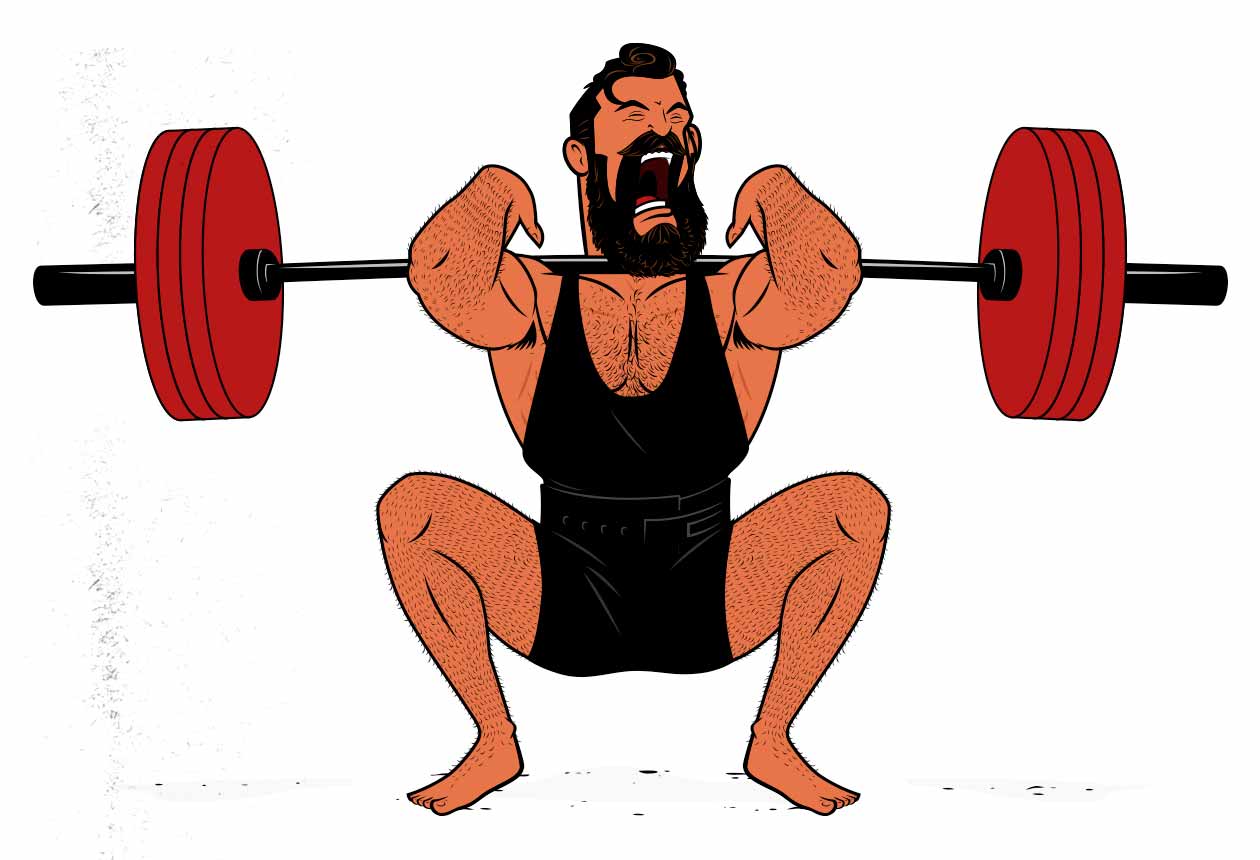
The second advantage to lifting weights more explosively is that it forces our bigger fast-twitch muscle fibres to engage (study). To become big and strong, we want to bulk up all of our muscle fibres, and so including lifts that train our fast-twitch muscle fibres is important. One way to do this is to lift closer to failure, another way is to lift heavier weights, and yet another way is to lift more explosively. So we have several options, but lifting explosively still helps.
The third advantage is that trying to lift the weight fast teaches our muscle fibres to engage together for a maximal effort, improving our maximal strength (study). This is why trying to accelerate the barbell is such an important component of strength training. But even during hypertrophy training, it’s an easy way to gain some extra maximal strength, improving our strength in lower rep ranges.
Finally, lifting weights fast also allows us to gain momentum during parts of the range of motion where we’re strong, allowing us to lift heavier weights through our sticking points. For some lifts, like the bench press and squat, it doesn’t matter very much, since the lifts have great strength curves anyway. But for lifts with poorer strength curves, such as biceps curls, chin-ups, and overhead presses, it can be a real boon.
Now, how much extra muscle growth does lifting explosively give us? If we look at a meta-analysis by Dr Brad Schoenfeld, beginners lifting more explosively gained slightly more muscle mass than the participants lifting more slowly, but the difference didn’t even reach statistical significance.
If we look at more experienced lifters, we see that trying to lift the weight explosively results in greater muscle activation and greater strength gains (study, study, study, study). Will this yield more muscle growth over time? It seems likely that it could. But at the very least, it will yield greater strength gains with an equivalent amount of muscle growth, making it a better default way of lifting.
Lifting more explosively is a great way to maximize both muscle growth and strength gains, and makes a great default way of lifting. The benefits are fairly modest, though.
Should You Pause Before Lifting the Weight?
There’s a common idea in powerlifting that when doing the bench press, you should pause with the weight on your chest before pressing it back up, or that you should pause in the hole of the squat before standing back up. The idea is that as we lower the weight down, we stretch our muscles our like elastics, and we activate the stretch-reflex, allowing us to explode out of the hole. This elastic tension is passive tension, though, and powerlifting is supposed to be about contracting our muscle fibres. I think that’s the idea, anyway. Maybe the pause is just there to standardize the lifts.
Thing is, tension is tension. When we stretch our muscles out, that passive tension is added to the force we can generate with our muscles, putting more overall tension on our muscles, and thus stimulating more overall muscle growth. That’s why using a deep range of motion is such a powerful way to stimulate more muscle growth. If adding a pause at the bottom of our lift reduces how much weight we can lift or how many reps we can do, it’s not a benefit, it’s a downside.
With that said, on both the squat and deadlift, the pause is at the deepest part of the lift, where our target muscles are stretched under a maximal load. That’s the very best part of the range of motion for stimulating muscle growth. By pausing at the bottom of the bench press, that’s extra time with our chest challenged under a deep stretch. And that’s fine. You can do that. The downside is that your triceps aren’t benefiting from the pause. And because you’ll be lifting less weight and doing fewer reps, that’s less stimulation for your triceps. Adding the pause, then, isn’t improving muscle growth, it’s just shifting a bit more of the emphasis to your chest. But because the chest is already the limiting factor on most people’s bench press, they wind up getting an equivalent amount of chest growth, but with less triceps growth.
As a result, paused lifts can make good assistance lifts in some situations. If someone has a lagging chest, adding a pause at the bottom of the bench press might help. But that’s typically done as an assistance lift, not a main lift. You’d do a standard bench press, trying to lift more weight and get more reps, and a pause bench press, to bring up your lagging chest.
Paused variations of the lifts can be useful assistance lifts, but for your main lifts, you should lift the weight as soon as you finish lowering it.
How Slowly Should You Lower the Weight?
When we lower the weight, our first priority is to keep our lifts safe. Depending on the lift, losing control of the weight as we drop it down can raise the injury risk. This also seems to be ideal for gaining muscle mass and strength. When comparing lowering speeds of 2–4 seconds, we see little difference in muscle growth or strength gains (study), but we do see that those moderate speeds produce more muscle growth than if we just drop the weight down quickly (study). So the exact amount of time you spend lowering the weight doesn’t seem to matter very much, but it is important to resist gravity and keep it under control.
Lowering the weight slowly and under control stimulates more muscle growth and in some circumstances is also safer.
What about SUPER Slow Lifting Tempos?
A more extreme lifting tempo is to slow the repetitions way down. For example, you might count to 7 while lifting the weight, then count to 7 again while lowering it, meaning that each repetition takes a whopping 14 seconds. When lifting this slowly, you’ll need to severely reduce the weight you’re lifting, resulting in quite a bit less muscle growth (study). It’s not an ideal way to train, and almost nobody does it anyway, but an article on lifting tempo would be incomplete without at least mentioning super-slow lifting tempos.
3 Common Examples
Bench Press Lifting Tempo
We can start with the bench press, a classic lift with a classic lifting tempo. The bench press starts with the weight in the top position, lowering it down into a position where our muscles are stretched, and then lifting it back up into the starting position. That’s about as perfect for building muscle as can be, and it’s the same situation that we have with most pushing exercises, such as squats, leg presses, Romanian deadlifts, skull crushers, and so on.
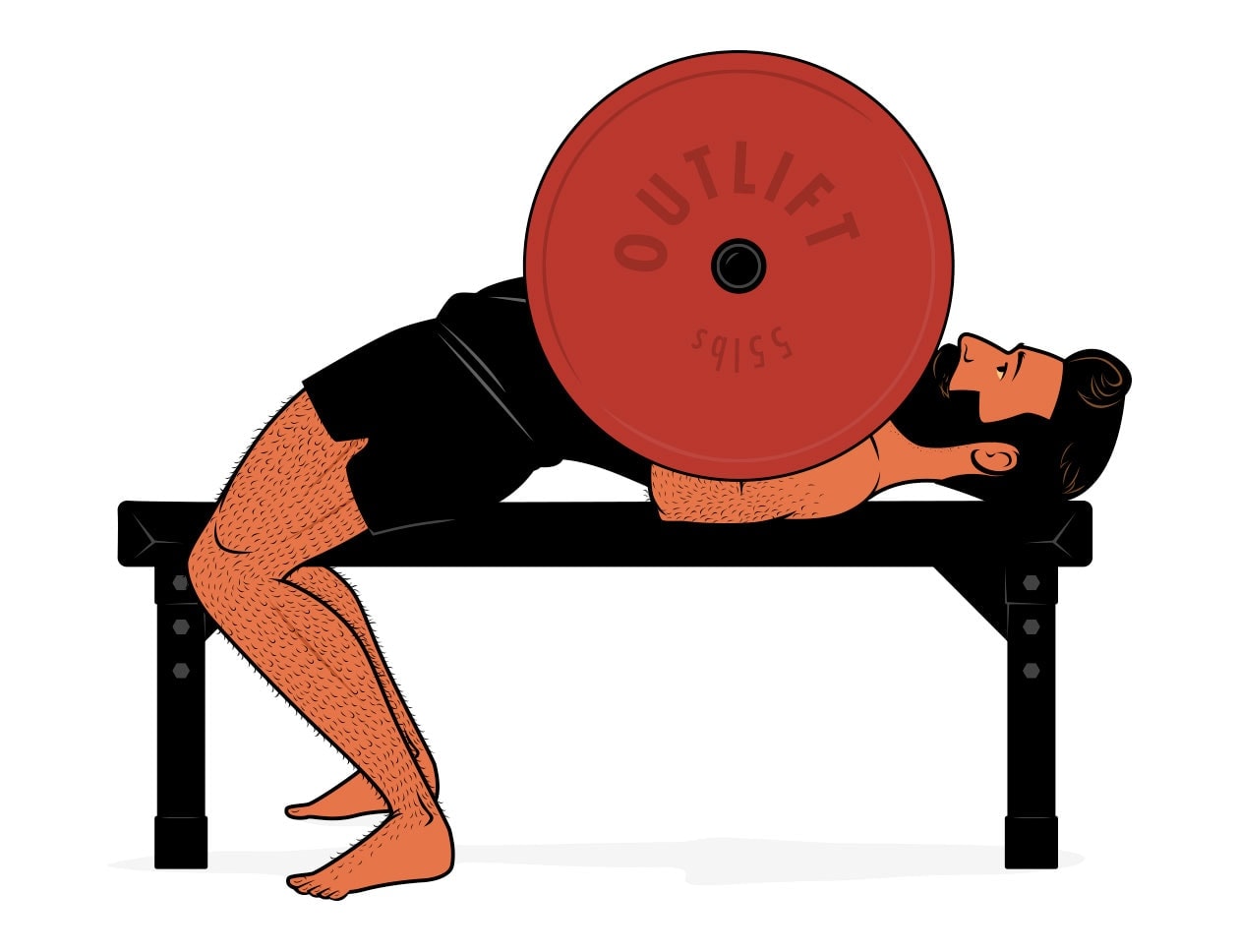
- The eccentric (the lift): the bench press starts at the top, so the first thing we need to do is lower the weight down to our chests. As we lower the weight down, we want to keep it under control, resisting gravity. If the weight isn’t challenging, you can lower it fairly quickly, taking a second or two, but if the weight is heavy, it might take several seconds. Take as long as you need.
- The isometric (the pause): once we’ve lowered the barbell down to our chests, our pecs are straining to keep it from resting on our ribcage. In this position, with our chests stretched and struggling, we have a good opportunity to stimulate muscle growth, and so it can help to pause for a second, as is common in powerlifting. But it depends on what you’re trying to do with your bench press. Pausing is good for your chest, but it will tire you out, limiting the number of reps you can do, which might not be ideal for your triceps. So when training for overall muscle growth, it’s often better to avoid the pause.
- The concentric (the lower): to lift the weight up, we want to lift explosively, accelerating the barbell up off our chests. If the weight is light, it will move fast, but if the weight is challenging, it will move slowly. If you’re at the end of a hard set or doing just a few reps per set, you’ll need to grind through slow reps, and that’s okay. Still, try to move the weight as fast as you can.
This is a classic tempo, lowering the weight down slowly and under control, pausing briefly under tension, and then lifting it back up explosively. If it takes you 2 seconds to lower the weight, you don’t pause, and then it takes you another second to lift it, you’d write that as 201—2 second lower, 0 second pause, 1 second lift. That gives the lift a 201 tempo.
Barbell Curl Lifting Tempo
For another example, let’s look at the barbell curl. This lift starts with our muscles at longer muscle lengths, we contract our muscles to lift the weight up, and then we lower the weight back down until it’s back at the starting position. This is the situation for most pulling exercises, such as the chin-up, pull-up, dumbbell row, and lat pulldown.
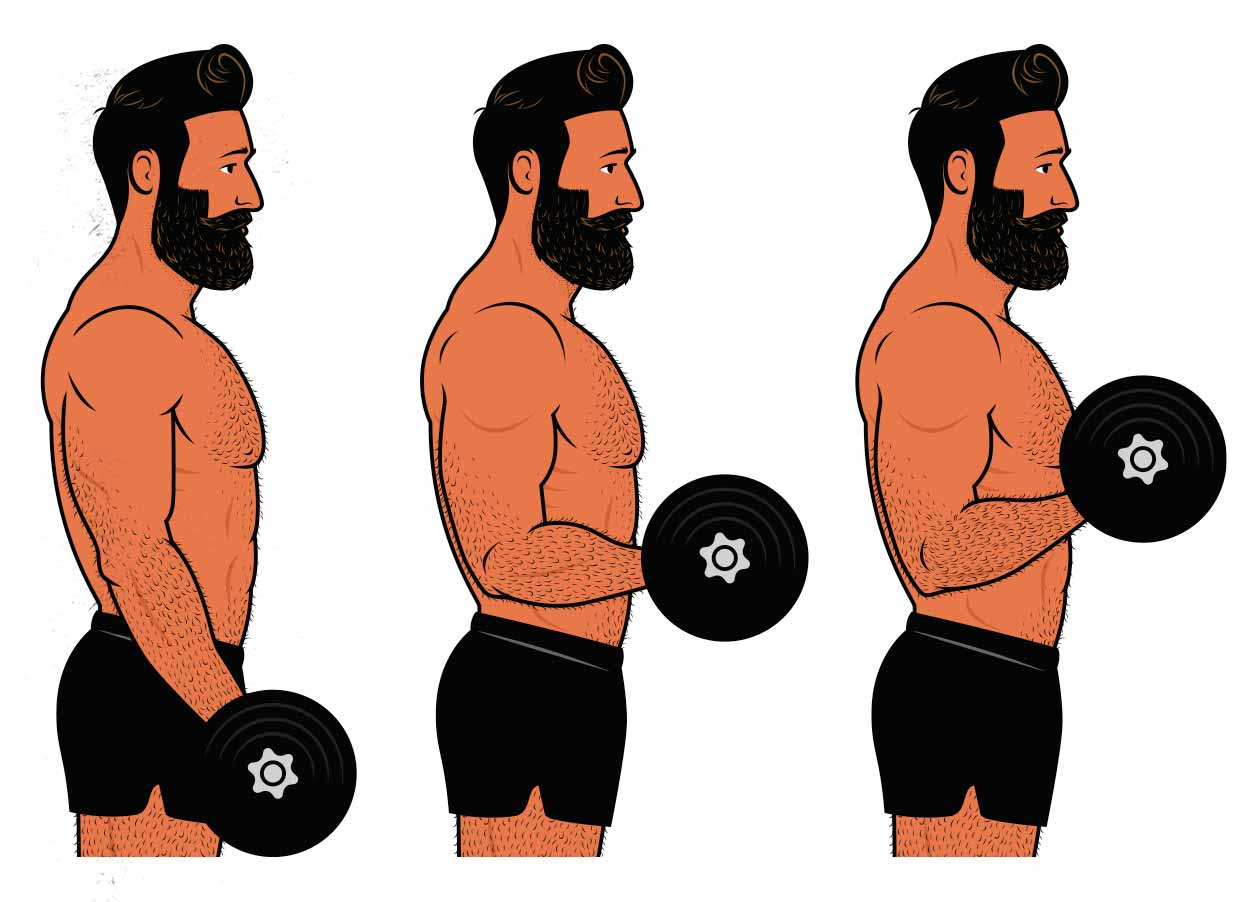
- The concentric (the lift): when doing barbell curls to gain muscle size and strength, you’ll want to lift the weight explosively, trying to accelerate the barbell up. If the weight is light, you’ll curl it up in less than a second. But if the weight is heavy, or if you’re at the end of a hard set, you’ll need to grind through it, and so it can take several seconds. However long the rep takes, though, we’re trying to move it quickly.
- The isometric (the pause): once we’ve curled the weight up, we’re flexing our biceps to hold it in that top position. There are some situations where we might want to pause with our muscles under tension, but this isn’t one of them. We’d just be burning through energy that we could use to do more reps. So once we curl the weight up, we begin to lower it back down.
- The eccentric (the lower): as we lower the weight down, we want to slow it down, resisting gravity. When we lift explosively, the temptation can be to drop the weight, but we shouldn’t. Lower the weight as slowly as you need to keep it under control, and try to feel your muscles working as you do it. 1–3 seconds is normally good, but take as long as you need.
So in this case, it might take a second to lift the weight, there’s no isometric contraction, we take 2 seconds to lower it back down, and then we begin our next rep. Again, we write that as 201.
Deadlift Lifting Tempo
For our final example, let’s look at the conventional deadlift, since this is a lift where people often recommend a different lifting tempo. As with the barbell curl, deadlifts start by lifting the weight. But what makes them different is that people often recommend lifting the weight up, pausing for a second at the top, and then dropping the barbell down to the ground. For instance, that’s how deadlifts are taught in both Starting Strength and StrongLifts. But is that the right way to do it? Yes and no.
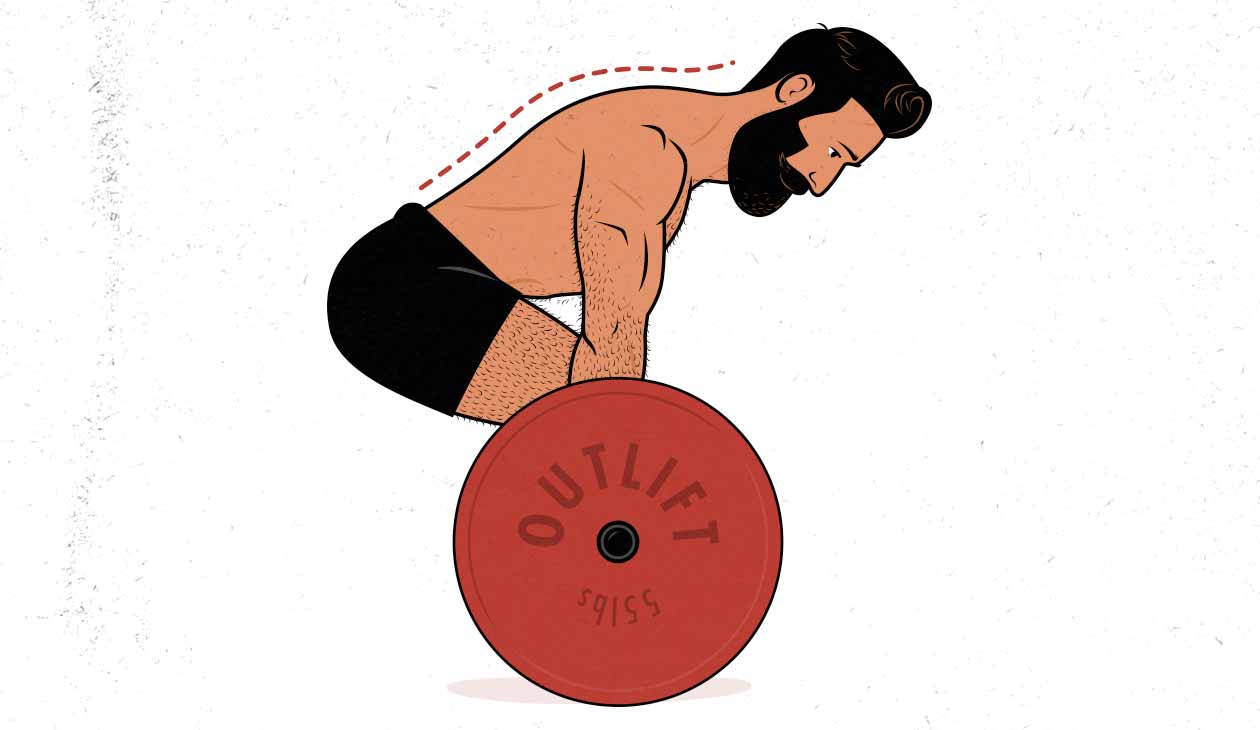
- The concentric (the lift): deadlifts start off fairly normally. The weight is resting on the ground, dead. We get into a good starting position, brace, and explode the weight off the ground. Now, when we say “explode,” we don’t mean that you should jerk the weight, we just mean that you should try to accelerate it off the ground. It’s a controlled motion, it’s just a powerful one.
- The isometric (the pause): once we’ve lifted the weight up, there’s no need to dilly dally at the top. After all, our hips and posterior chain aren’t loaded in that top position. The weight is held in our hands and hanging off our traps, burning up energy, but we aren’t loading the prime movers. Better to start lowering the weight.
- The eccentric (the lower): for powerlifters and Olympic weightlifters, it’s common to lift the weight up, drop it down, take a moment to find the starting position again, and then do another rep. If you’re training to gain muscle mass, though, you want to take advantage of the muscle growth that the eccentric stimulates. It’s best to lower the weight down slowly and under control, just like with any other lift. And because you’re lowering the weight down under control, you can lower it back into the correct starting position, removing the need to reset between reps. Instead of lifting, dropping, and reseting, you can lift, lower, and go right back to lifting.
The deadlift is often criticized for having a low stimulus-to-fatigue ratio—for being disproportionately fatiguing per unit of muscle growth that you get out of it. But when you deadlift with the goal of building muscle, you can adjust the tempo so that you get more muscle growth out of every rep, largely fixing this issue.
This is the same situation as with several other lifts that are commonly used by both bodybuilders and powerlifters. For instance, the barbell row and overhead press are often done with a similar tempo as the deadlift, exploding the weight up and then dropping it back down. But again, if we’re lifting to gain muscle mass, we want to lower the weight slowly and under control.
Summary
Different lifting tempos can be used for different goals, but the best tempo for gaining muscle size and strength is to lift the weight explosively and then lower it down under control. The amount of time it takes you to complete each rep can vary based on what lift you’re doing and how heavy the weights are, but the goal is to intentionally speed up the lifting portion, then intentionally slow down the lowering portion. During most of the reps on most of your sets, maybe it takes you a second to lift the weight, 2–4 seconds to lower it.
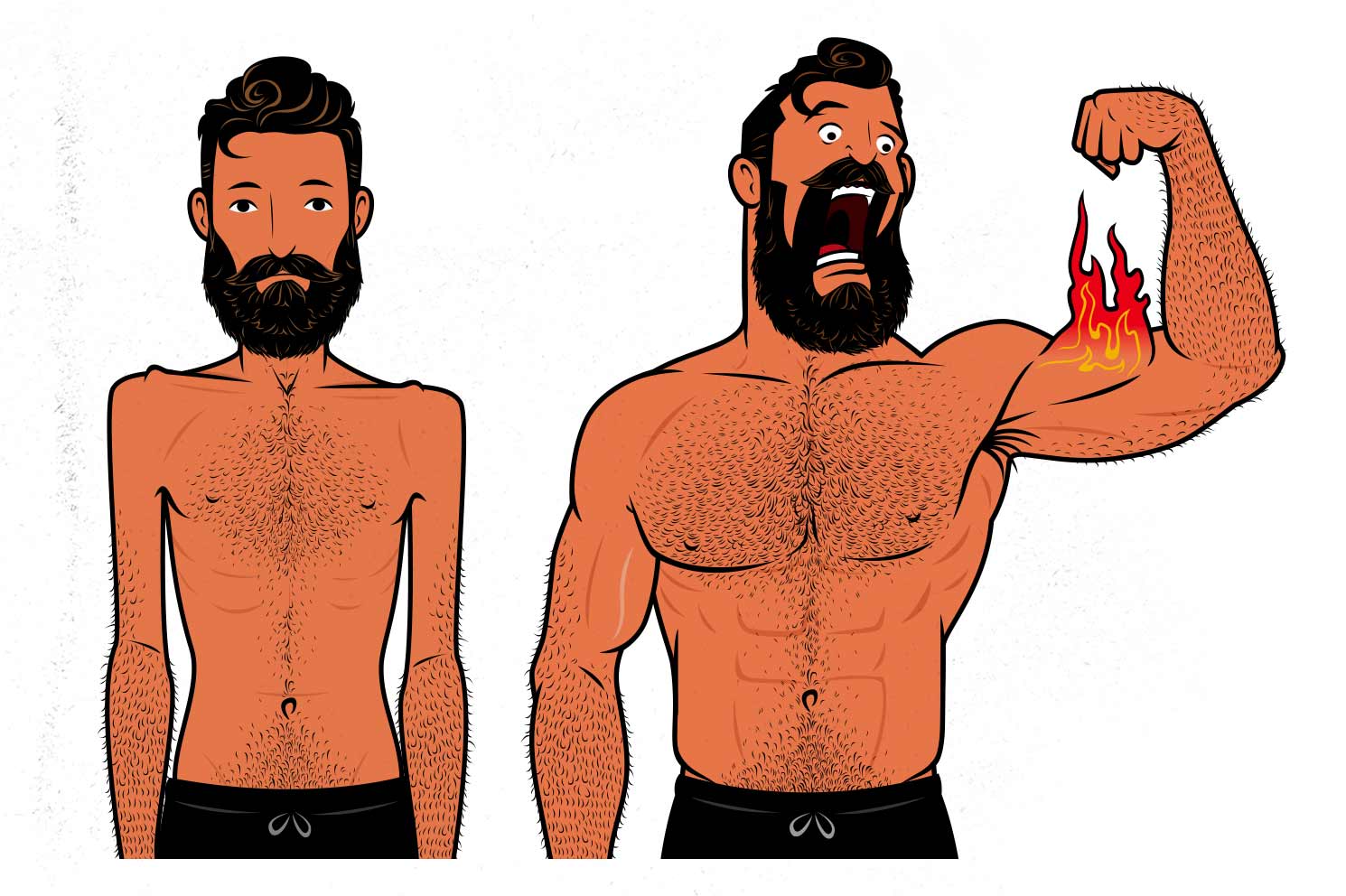
For example, when doing a set of barbell curls, it might take you around a second to lift the weight up. You don’t need to count how long it takes, though, you just need to focus on fully engaging your biceps right from the very beginning of the repetition. Plus, by the end of the set, as you’re grinding out your final rep, you may find that it takes you a few seconds to lift the barbell past your sticking point. This emphasis on lifting explosively might stimulate more muscle growth, and it will definitely help you gain more strength.
Then, when you lower the weight back down, you don’t need to try to keep it slow, but you should be thinking about resisting gravity, feeling your biceps working, and keeping the barbell under control. That extra work will stimulate a bit of extra muscle growth.
This idea of lifting explosively and lowering under control applies to almost every lift, including deadlifts, overhead presses, and barbell rows. By lowering the weights under control instead of dropping them, you’ll stimulate more muscle growth, and you’ll save yourself from needing to reset between each rep. This is true for gaining muscle mass as well as for gaining strength.
In some cases, such as with a pause squat or pause bench press, you might want to pause with your muscles in a deep stretch. This can be helpful for stimulating muscle growth and improving your strength at the bottom of the lift. But because adding the pause reduces how much weight you can lift, it doesn’t tend to produce more overall muscle growth, it just tends to shift that muscle growth around a bit. For example, on the bench press, it means more work for your pecs, less for your triceps. Most people are already limited by their chest strength on the bench press, and so it’s usually a better default to avoid the pause, working your triceps a bit harder. That’s why pause bench presses are typically used as an assistance lift, not a main lift.

As always, if you want a customizable workout program (and full guide) that builds these principles in, check out our Outlift Intermediate Bulking Program. We also have our Bony to Beastly (men’s) program and Bony to Bombshell (women’s) program for skinny and skinny-fat beginners. If you liked this article, I think you’d love our full programs.







Hi Shane, lifting very light weights with very slow tempo is an attempt to make them feel heavier. I personally don’t like it, it gets too boring as well.
Lifting heavy weights with normal to fast tempo also engages all target muscles if the technique is good. Powerlifters are quite jacked and have good size all by this. Secondly, you can’t lift a heavy weight slowly, it won’t move.
Hey Farhan, yeah, slower lifting tempos allow you to get more challenge out of lighter weights, which can work, but it’s a better default to lift more explosively with heavier weights. And that’s a good point: it’s more fun, less painful.
I’ll just point out that if you’re lifting heavy weights, they’ll probably move slowly. When lifting weights that are really close to your 1-rep max, you’ll probably need to lower it pretty slowly to keep it under control, and then when you go to lift it, it can be a real grind. It took me 7 seconds to finish a bench press rep with 315 pounds, during which time I could have done 7 reps with 225, you know?
Yes Shane, I understand your point. I think there comes in personal preferences also. Some might like one over other. Our neurological profiles play a great role here too.
Christian Thib has great series of videos on YouTube about various neuorotypes and training modalities according to that.
Have you guys ever read Body By Science? It’s basically a 10/10 lifting cadence performed approximately once per week whole body. I’m 32, and I’m making great gains with a B.B.S. -esque A/B workout routine. That study about slower tempo and lighter weights not adding muscle is pure bunk guys.
I didn’t gain until I found this material. I’m not to the right of the bell curve in terms of recovery and muscular potential, and the extra rest/lower volume/higher intensity advocated on B.B.S. and HIT in general works better for me.
Hey Alex, that’s sweet that it’s working well for you.
There are plenty of different techniques that can work. I never meant to imply that if you don’t lift with this tempo, you can’t make progress. But the research pretty clearly shows that using heavier weights and a more explosive concentric is better for building muscle.
Training with slower tempos, lower frequencies, and going to absolute failure is okay. You can get results that way. And it doesn’t demand much time spent training, which is great. It’s not the fastest way to build muscle, though. I’m not even sure it’s the most efficient. But that doesn’t mean it’s bad. And some people may respond better to it.
I want to write a full article on HIT, too. I think that would be a cool one.
Hey
I started to build muscles in three months but I was getting pain in starting. Now I read your all blogs about fitness, body weight, body lifting, and many more. I regularly follow your tips and ideas now I do exercise more than before without any pain.
kv45bx
Hi Shane, I hope you are well. When I lift at a slow tempo, I feel that my muscles are not contracting well and I am trying in vain, but when I lift at a normal or fast tempo, I feel that my muscles are contracting better and I am close to muscle failure. What do you think about this?
I think most people have an easier time feeling their muscles when they lift more slowly, so you may be unusual in that regard. My experience is similar to yours, though. I can feel my muscles working pretty well when I try to lift more powerfully, athletically, and explosively. That’s especially true during the earlier reps of a set, when lifting with a slower tempo feels much too easy.
As for gaining muscle and strength, there’s no reason to slow your lifting tempo down, but you do want to slow down the lowering part. Think of exploding the weight up and then resisting gravity on the way down, lowering it slowly and under control.
After exploring once more all the vagaries of lifting styles, I’ve come back home to Dorian Yates on reverb. Nice and slow reps, drop sets immediately thereafter. If you actually go to full failure, pushing past all the mental and physical pain to the point of true muscular failure, this is all you need. Most people never approach true failure. It’s damn hard. Lateral raises? Bicep curl? It’s brutal. But it works and you don’t have to think about programming ever again… which is why it isn’t popular among folks who make a living selling fitness programs. And I don’t blame anybody for that, nor do I think the programs won’t “work.” But the most important factor in stimulating muscle growth is intensity. Schoenfeld, et al. Doesn’t matter. It’s all there in the literature. Most programs recommend at least a “technical” failure as a nod to this principle, and then add working sets to compensate for not finding true failure.
After training with Jay Vincent, I’ve come to understand what failure really looks like and my physique is growing rapidly. 6-7 exercises, 3 way split, not lifting weights but contracting and stimulating the targeted muscles through the most efficient means – which ultimately means machines with as low as friction as possible.
Bodybuilding isn’t strength training. It’s stimulating and growing muscles through the most efficient means possible. This looks nothing like what we think it does, but it does come without all the injuries from lifting tendon and joint destroying barbells and dumbbells “athletically.”
Gained 30lbs injury free. Rapidly gaining more. Find true failure and grow.
Intensity is tricky because it can mean either a percentage of 1-rep max (e.g. 80% intensity) or proximity to failure (e.g. 1 rep in reserve). I think you mean proximity to failure. I agree that training closer to failure tends to stimulate more muscle growth. I also agree that most people could benefit from pushing themselves harder.
Whether bodybuilding is the same as strength training depends on how you define the terms. Many people use the terms interchangeably, where strength training is any sort of resistance training that causes strength adaptations, and bodybuilding is any sort of resistance training that provokes muscle growth. By those definitions, any sort of resistance training could be called bodybuilding or strength training. But I agree with you that it’s more helpful to think of them as separate, with strength training often rooted in powerlifting culture and bodybuilding typically rooted in bodybuilding culture.
It’s wise to consider financial motivations, but I don’t think people who sell fitness programs are biased toward making things more complicated. That’s because selling simple concepts is easier than selling complicated ones.
Consider a few of the more marketable fads:
-Carbs are bad (keto)
-Gluten is bad
-Animal products are bad (veganism)
-Plant-based products are bad (carnivore)
-Breakfast is bad (intermittent fasting)
-Effort is all that matters (HIT)
-Macros are all that matters (IIFYM)
-Insulin is all that matters (CIM)
-Calories are all that matter (CICO)
-Inflammation is all that matters
-Seed oils are the root of all evil
These are caricatures of concepts that (sometimes) contain some nuance, but you get the idea: the most viral and marketable concepts can often by summarized in a simple sentence fragment.
Minimalist programs like Starting Strength and StrongLifts are super successful, too.
The simpler you can make something, the more accessible it is, and the easier it is to sell.
Selling complexity is much harder.
To add another anecdote to yours, Marco and I have each gained 70 pounds naturally. Barbells were the foundation of our training, though we also used dumbbells, bodyweight exercises, and exercise machines. I often lift to failure. Marco almost never does.
Oh, I think I said it wrong, I meant that with a faster tempo, I can experience better mechanical tension, as well as better growth, especially in movements such as overhead press, bench press and full squat, but in back exercises such as dumbbell curls or barbell curls, a slower tempo causes tension. More in my muscles. Overall, it was an interesting article and I read it again and enjoyed it. Love to you from Iran
Thanks, Amir!
It makes sense that different exercises feel different. The exercises you mentioned all have different strength and resistance curves. I think lifting with a more explosive tempo works well for almost all muscles and exercises, though.